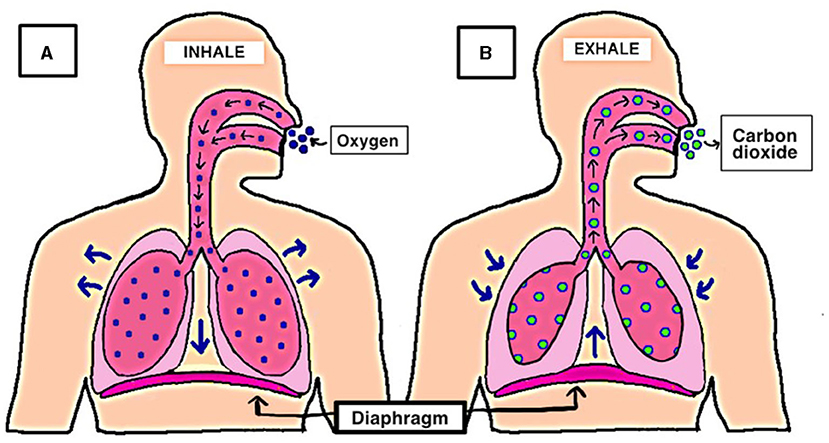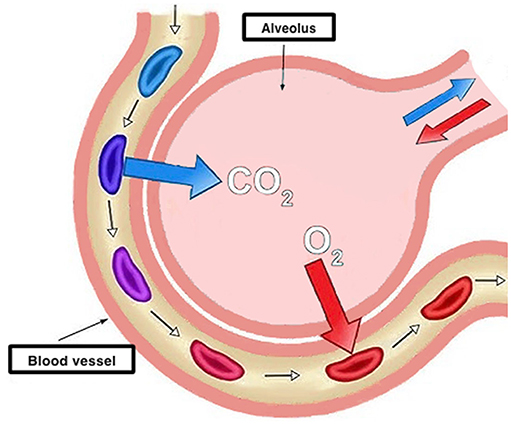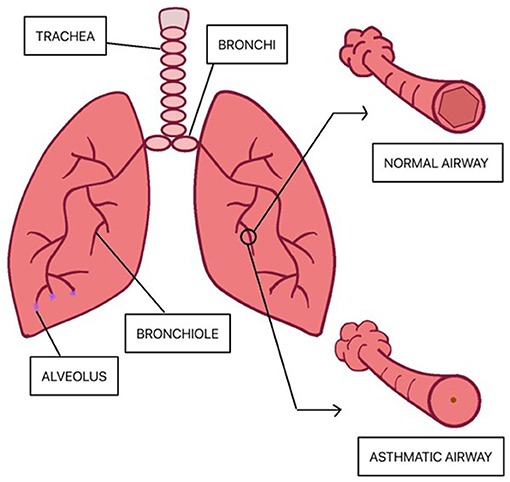Abstract
Lungs are important for helping you breathe in the oxygen that your body needs to function. Health conditions like asthma can make it difficult for some people to breathe properly. Asthma is a common condition seen in children. Asthma can occur when certain things irritate the airways of the lungs, making them smaller and blocked with mucus. This makes it difficult for air to move in and out of the lungs, causing coughing, wheezing, and trouble breathing. Asthma can be due to a mixture of things in the environment and in the genes that kids inherit from their families. However, there are certain triggers that can make asthma worse, including allergies, cold weather, and exercise. But not to worry, with the right help from doctors and the proper medications, children with asthma can still do all the things they love!
How Do Your Lungs Work?
Take a deep breath in and out, watch your chest rise and fall—that is your lungs in action! For your body to function, you need oxygen (O2). O2 is a small molecule that can be found in the air around you. Your lungs allow you to breathe in O2-containing air so that your body can use it for energy, keeping you alive. When you take a deep breath in, the air travels through your nostrils into a windpipe structure called the trachea. The trachea divides into two main tubes called the bronchi. The right bronchus enters the right lung and the left bronchus enters the left lung. Each bronchus further divides into smaller branches inside the lung, much like the spreading branches of trees. The ends of the small branches have small, spongy air sacs called alveoli. O2 travels all the way down to the alveoli, where it can be transferred into the bloodstream to provide the rest of the body with oxygen. Another important function of the lungs is to remove waste products like carbon dioxide (CO2) from the body. While O2 enters the bloodstream, CO2 from the bloodstream enters the alveoli to be exhaled out into the environment (Figures 1, 2).

- Figure 1 - Cycles of inhalation and exhalation.
- (A) During inhalation, you take in O2 from the air, which enters the lungs. The downward movement (contraction) of the diaphragm and the expansion of the lungs help O2 enter the lungs. (B) During exhalation, CO2 is removed from the body. The upward movement (relaxation) of the diaphragm and contraction of the lungs helps with the removal of CO2.

- Figure 2 - Blood and gas exchange at the level of the alveolus.
- With every breath, O2 makes its way down to the alveoli in the lungs. Alveoli are very close to blood vessels, which allows gas exchange to occur. O2 leaves the alveolus and enters the blood vessel so that the body can use the O2. At the same time, the waste product CO2 leaves the blood vessel and enters the alveolus so that it can be breathed out.
The lungs receive help from a dome-shaped muscle called the diaphragm. Sitting just below the lungs, the diaphragm contracts to allow the lungs to expand, like balloons, to bring air in. When the diaphragm relaxes, the lungs shrink back to their normal size, forcing air out. Taking a breath seems easy and natural. However, breathing can be challenging for people with asthma.
What is Asthma and What Causes it?
Asthma is a lung condition that causes breathing problems. In asthma, the airways become inflamed and narrow, making it harder for the affected person to breathe in and out. More than 300 million people are affected by asthma worldwide [1]. Asthma can affect anyone, but it is more commonly seen in children. There is no one specific cause of asthma. Instead, asthma is due to an interaction between things in the environment and a person’s genes [2].
Certain individuals are at higher risk of developing asthma. Children with parents who have asthma have a higher chance of getting asthma. Asthma is also more likely to develop in people who have allergic conditions, such as food allergies. Sometimes, events that occurred early in life can be related to developing asthma, such as low birth weight, an early birth, exposure to air pollution and cigarette smoke, and getting sick with certain viral infections [3]. Asthma can occur at any stage of a person’s life, even if they have no family history of the condition.
Asthma occurs when cells in your body, called white blood cells, move into the airways. There are several important types of white blood cells, and their role is to protect people against many illnesses. The movement of these cells into the airways is called inflammation. White blood cells release certain chemicals that cause the airways to swell, the muscles in the airways to tighten, and thick mucus to be made [4]. When these things happen, the airways become narrow, making it difficult for air to move into them.
Over time, after repeated episodes of inflammation where white blood cells continuously invade the airways, the airways begin to change their structure, which is known as airway remodeling. Changes include the thickening of the airway walls, increased mucus production, and release of various proteins, which further contribute to airway narrowing and reduced flow of air into the lungs (Figure 3).

- Figure 3 - Differences between a normal and asthmatic airway.
- Following exposure to certain triggers, the body of a person with asthma responds by sending white blood cells into the airways. This immune reaction causes the airways to become tighter, smaller, and filled with mucus, making it difficult to breathe.
Asthma is the body’s way of responding to triggers—things that can make asthma flare up. Triggers can be different from person to person, but some common triggers include respiratory infections, allergies to pollen, weather conditions, and exercise. During an asthma attack, white blood cells make antibodies to the proteins of certain triggers. When the person is exposed to a certain trigger again, the antibodies quickly recognize it and tag the trigger for destruction by the white blood cells. Together, all these events lead to an asthma attack.
What are the Symptoms of Asthma?
Some common symptoms that people with asthma may experience include cough, shortness of breath, chest tightness, and wheezing [4]. Asthma symptoms can come and go and may be triggered by activities such as exercise and allergens in the environment (e.g., pollen and cigarette smoke). For example, a person might have an asthma attack while playing outside at school or during the springtime when flowers and plants begin to release pollen into the air. Asthma symptoms may also worsen at night, making it very difficult to get a good night’s sleep. People with asthma may also experience allergies and a skin condition called eczema, as these conditions often occur together.
If asthma worsens for a short period of time, this is called an asthma attack. During an asthma attack, a person might have a very difficult time breathing and try to breathe more quickly, experience an increased heart rate, chest tightness, and difficulty talking. Asthma attacks can last anywhere from a few minutes to days, depending on how severe the asthma is. An asthma attack may also keep the person up at night and prevent them from lying down. When kids notice their asthma symptoms coming on, it is important to let their parents or caregiver know as soon as possible so that the adults can give the child their medications to improve their symptoms. If the person notices that they are not feeling better even after using their medications, it is important to get medical help immediately. Severe asthma attacks can be life-threatening and may require admission to the hospital and emergency medical care. Although asthma may sound scary, there are many ways to reduce the chances of an asthma attack and improve symptoms so that a person can continue to do the things they love!
Can We Improve Asthma?
To treat asthma, people should try to avoid things that make their asthma worse. If they have any allergies, they will want to avoid those allergens. Doctors can help people with asthma create a plan to avoid the things they are allergic to. Common allergens that may trigger asthma include pollen from plants, cigarette smoke, dust, and even pets. Interestingly, certain emotions such as stress or laughing can also trigger asthma.
Although exercise can also be an asthma trigger for certain individuals and might prevent them from participating in physical activity, it is important for people with asthma to stay active. If exercise is a trigger, a person’s doctor can prescribe a medication that the person can take before any physical activity, to prevent the airways from tightening up. As a fun fact, many professional athletes have asthma!
Other than avoiding triggers, being up to date with vaccinations is also important. For example, viral infections, such as influenza virus (or “the flu”) can trigger an asthma attack. Getting a yearly flu vaccine can prevent this.
Doctors may give people with asthma medicines called inhalers. Inhalers can help improve asthma symptoms, allowing the person to breathe easily once again [5]. Depending on the asthma severity, inhalers with steroids may be prescribed to control the inflammation. It is important to understand the proper technique for using an inhaler, as using it incorrectly can lead to poor asthma control, ultimately resulting in an asthma attack [2]. Fortunately, using an inhaler is very easy! Doctors can show asthma patients how to use an inhaler, to make sure they are ready to treat their asthma and improve their symptoms.
Beating Asthma: The Final Tips
In summary, asthma is a lung condition that affects many people around the world. Asthma causes the airways to become irritated, narrow, and filled with mucus. Due to the combination of environmental and biological causes, asthma may run in families and occur with conditions such as allergies and eczema. When a person has asthma, they will experience a range of symptoms that make breathing very difficult. Although asthma can affect a person’s day-to-day activities, certain treatments can improve symptoms and help people to breathe easily once again. With the proper asthma care plan and the right medicines taken correctly, a person with asthma can do just about anything!
Glossary
Trachea: ↑ A tube that carries air from the nose and mouth all the way down to the division into bronchi.
Bronchi: ↑ Two tubes that arise from the separation of the trachea. These tubes carry air into the lungs.
Alveoli: ↑ Small air sacs inside the lungs that are in proximity with blood vessels, allowing sufficient gas exchange to occur.
White Blood Cells: ↑ Cells found in the blood that are important for fighting infections, diseases, and allergens.
Antibodies: ↑ Special proteins made by the immune system in the body to protect from germs.
Allergens: ↑ Substances that can make some people’s immune system react, causing sneezing, itching, and other allergy symptoms.
Inhalers: ↑ Devices that provide medicine that is breathed in through the mouth and goes to the lungs to help the airways relax and open.
Steroids: ↑ Special medicines that calm down the body’s immune system which can help stop symptoms like swelling or itching. Doctors prescribe them to treat certain medical conditions like asthma or allergies.
Conflict of Interest
The authors declare that the research was conducted in the absence of any commercial or financial relationships that could be construed as a potential conflict of interest.
References
[1] ↑ To, T., Stanojevic, S., Moores, G., Gershon, A. S., Bateman, E. D., Cruz, A. A., et al. 2012. Global asthma prevalence in adults: findings from the cross-sectional world health survey. BMC Public Health. 12:204. doi: 10.1186/1471-2458-12-204
[2] ↑ Jones, H., Lawton, A., Gupta, A. 2022. Asthma attacks in children-challenges and opportunities. Indian J. Pediatr. 89:373–377. doi: 10.1007/s12098-021-04069-w
[3] ↑ Castro-Rodriguez, J. A., Forno, E., Rodriguez-Martinez, C. E., Celedón, J. C. 2016. Risk and protective factors for childhood asthma: what is the evidence? J. Allergy Clin. Immunol. Pract. 4:1111–1122. doi: 10.1016/j.jaip.2016.05.003
[4] ↑ Shipp, C. L., Gergen, P. J., Gern, J. E., Matsui, E. C., Guilbert, T. W. 2023. Asthma management in children. J. Allergy Clin. Immunol. Pract. 11:9–18. doi: 10.1016/j.jaip.2022.10.031
[5] ↑ Devonshire, A. L., Kumar, R. 2019. Pediatric asthma: principles and treatment. Allergy Asthma Proc. 40:389–392. doi: 10.2500/aap.2019.40.4254
